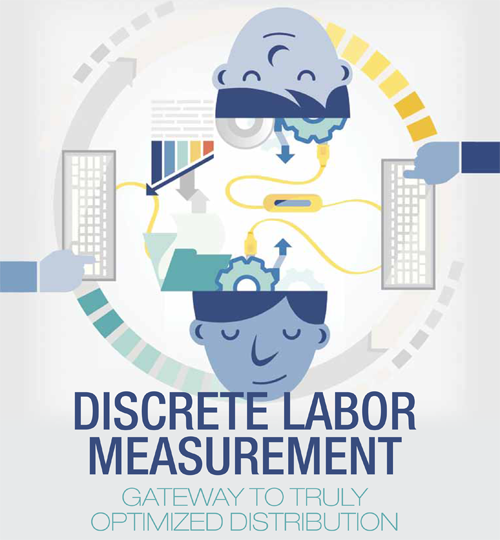Discrete labor management

By George Bishop
Distribution centers remain under constant pressure to reduce costs and increase service levels. To address these challenges, companies are exploring a wide variety of tools and technologies to shrink their costs and satisfy the growing expectations of their cyber-driven clients that expect fast, economical and accurate service. While some major manufacturers in the automotive and electronic spaces are introducing robotics and automation into their assembly lines, machines aren’t replacing distribution center employees yet. Humans add necessary problem-solving skills and adaptability to many distribution tasks. Given the tasks and customer demands at hand, it’s critical to be able to optimize a distribution environment through a more efficient use of its workforce.
Look closely and you’ll see that distributors’ best tool might not be a robot, but a data point. And thanks to a flood of new software available in the market, distributors have the resources required to make the most of their human workforce through data-driven advanced planning and management.
Tech mega trends like cloud computing and Big Data are evident across multiple lines of business, from customer service to sales and marketing. While new tech adoption has been less prevalent among distributors, the industry’s attitude might be changing.
To better understand the efficiency of their operations and add some accountability to the distribution process, over the past 50 years, more and more operators have come to rely on Engineered Labor Standards (ELS) and Labor Measurement Systems (LMS). The early systems, basic in nature, were dependent on historical data and some engineering to generate minimum expectations in the form of units per hour (e.g. tons per hour, lines per hour, cases per hour, pallets per hour). This was a first step in the right direction, but they lacked the ability to truly map the processes and to adapt to changes in the distribution environment. Today, fortunately, advances in computational power combined with affordable, robust real-time data capture have spawned a new generation of LMS.
For the most part, operators using the previous generation of LMS, often referred to as “discrete LMS,” have been successful at managing the productivity of the various distribution center functions (e.g. receiving, putaways, order selection, replenishments, loading). Unfortunately, the distribution center’s organizational structure and the focus on the individual functions narrowed managers’ perspective to the point of tunnel vision and introduced a phenomenon called the “Silo Effect.” The “Silo Effect” results in the optimization of individual distribution functions, to the detriment of the overall system efficiency. Some of the more obvious negative issues linked to this phenomenon include:
- Wasted time: Occurs mainly when different functions of the distribution process operate out of sequence. Lost time is often observed when there is a lack of synchronization between the forward pick location replenishments and the order selection process. This typically results in one of two situations: either order selectors spending time waiting for a replenishment to occur or order selectors having to “short” products due to a late replenishment. The ensuing process to pick the short is non-value added and another example of the negative impact of the silo effect.
- Congestion: Additional congestion tends to result when a pallet’s flow becomes un-balanced. Early replenishments result in pallets in the aisles that can obstruct the movement of pallet jacks and forklifts. An accumulation of outbound pallets on the dock creates even more jamming for the order selectors and loaders.
- Damages: Germane to congestion, damages are typically linked to pallets and products sitting in the aisles where vehicles travel and are likely to collide with each other.
At a higher level, the Silo Effect is also omnipresent in facilities that require close interaction between departments. Most distribution facilities require some level of product consolidation prior to loading that results from different factors, such as products originating from different departments (e.g. dry, chemicals, chilled, frozen) in the facility, or the use of multiple selection methods (e.g. pick to light, pick to belt, pallet jack, high level pick). The two-fold challenge here is to optimize the various functions within a given department, but also across departments. This serves to minimize the congestion on the docks and maintain a steady flow of pallets to prevent loading process disruption and meet the shipping schedule.
Many of the side effects seen with discrete LMS are eliminated in more modern systems, which incorporate both discrete modeling capabilities as well as a real-time information loop. The ability to collect data inputs as they’re produced (from employee tasks and workflow – often through Radio Frequency “RF” technologies) allows the LMS to both enhance its modeling accuracy, and send relevant updates to managers to better understand their operations. The presence of the right information, at the right time, in a human friendly format radically changes the dynamics of managing distribution center operations.
Imagine a planning process by which you can schedule your different functions and departments based on Discrete Engineered Labor Standards (DELS). Your scheduling process starts with an accurate model of your operations. You may be thinking, “This is great, but what if unexpected events derail the original plan?”
This is where real-time data acquisition combined with discrete modeling shines. The ability to aggregate real-time information into instruments on a dashboard that monitors the progress of the operations enables management to quickly identify and react to those unforeseen events.
This data is also the key to addressing the aforementioned Silo Effect. Instead of relying on after- the-fact information provided by static reports, a distribution center operator can now monitor in real-time the synchronicity of each process. A quick glance at the dashboard instrument panel suffices to show not only how well each function and each department is progressing, but also the interrelationship between those two. It becomes easy to see if the forklift operations are too far ahead or too far behind the order selection process. Management can quickly assess if products are accumulating on the dock and the reasons behind the buildup. Specialized dashboard instruments can even be set up to run “what-if” scenarios with regards to moving associates to a different function or a different department
Through these kinds of data-driven resources, distribution center leadership can tear down those silos, achieve optimal performance, and fully benefit from the information that is now accessible. Combining these programs with other assets like RF technology makes distributors’ existing information that much more powerful.
And with increased transparency into the current state of their workforce operations, managers are equipped to make better decisions about staff assignments and warehouse layout. This translates into faster turnarounds and more human accuracy – which ultimately minimize overtime pay expenses and workers comp claims.
The positive returns of a data processing program become more visible over time. Months worth of small tweaks to the floor layout or employee configuration can eventually put a distribution center in the position to manage higher volumes with the same or fewer staff members. In the further-out future, distributors might be able to eliminate certain pieces of equipment, lowering energy consumption and reducing operating and maintenance costs.
From this vantage point, it’s easy to envision an entirely redesigned breed of facilities based on real-time data-based engineered labor standards. Tomorrow’s distribution center could be a far cry from what we know now, right down to the size of the parking lot configuration – all while maintaining extreme efficiency. Wearable devices, not unlike Google Glass or other Heads-Up Display (HUD) glasses, will further radicalize internal distribution center communication and workflow.
Today’s global distribution industry is faced with a number of challenges, both economic and labor-related, as well as opportunities. The businesses that embrace new technologies now to make the most out of the data they already store are best positioned to compete and scale in the long-term. And without question, humans will remain a large, critical part of reaching that success.
 George Bishop is a director and industrial engineer at West Monroe Partners’ Operations Excellence practice. Learn more at www.westmonroepartners.com.
George Bishop is a director and industrial engineer at West Monroe Partners’ Operations Excellence practice. Learn more at www.westmonroepartners.com.
This article originally appeared in the Jan./Feb. 2014 issue of Industrial Supply magazine. Copyright 2014, Direct Business Media.













